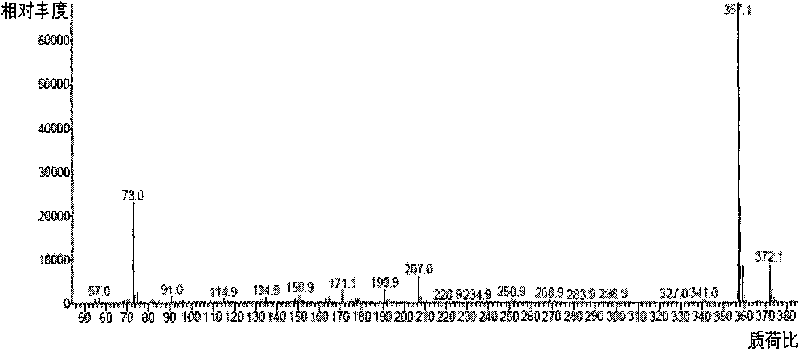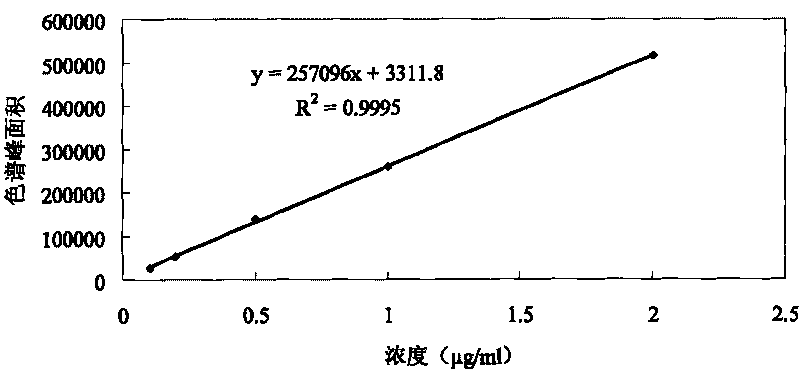Method for measuring bisphenol A in product by gas chromatography-mass spectrometry
A gas chromatography and mass spectrometry technology, applied in the detection field of bisphenol A in products, can solve the problems of high solvent consumption, unsatisfactory detection effect and high detection cost in liquid chromatography analysis, and achieves low detection limit and low interference. , The effect of low detection cost
- Summary
- Abstract
- Description
- Claims
- Application Information
AI Technical Summary
Problems solved by technology
Method used
Image
Examples
Embodiment 1
[0023] Accurately weigh 1.0mg of bisphenol A, dissolve it with an appropriate amount of acetone, transfer it to a 200ml volumetric flask, and dilute to the mark with acetone. Shake well and let stand to get 5μg / ml BPA standard solution. The solution used for the test working curve of BPA is diluted step by step from the above 5μg / ml standard solution, respectively prepared into a series of solutions of 0.1, 0.2, 0.5, 1.0, 2.0μg / ml, and hexamethyldisilazane is added to bisphenol A Carry out silanization derivation, the derivative liquid is filtered through a 0.45 μm needle-type organic phase filter head, and then analyzed and detected by gas chromatography-mass spectrometry instrument GC-MS according to the above experimental conditions, wherein the gas chromatography-mass spectrometry instrument inlet temperature is set to The temperature at the interface of the gas chromatograph-mass spectrometer is set at 280°C; the carrier gas is high-purity helium, and the flow rate is 1 m...
Embodiment 2
[0026] Measure a polycarbonate sample of 100 square centimeters in a 500ml beaker, add a corresponding amount of acetone in the ratio of area:solvent=1:2 (square centimeter:milliliter), soak and extract at 40°C for 4 hours (the sample needs to be completely immersion). After filtering the extract, take 5ml into a 20ml headspace bottle, add 400μl of hexamethyldisilazane, and derivatize at 50°C for 5 hours. After the derivative liquid is filtered through a 0.45 μm needle-type organic phase filter head, the filtered extract is tested and analyzed by a gas chromatography-mass spectrometer, and the test and analysis experimental conditions of the gas chromatography-mass spectrometer are the same as in Example 1. Quantification by external standard method. Three parallel samples were made to the polycarbonate sample, the test numbers were A, B, and C, and the analysis results were shown in Table 1, and the first parallel sample (test number A) was measured 5 times, and the analysis...
Embodiment 3
[0032] The standard solution in Example 1 was added to the prepared test solution with known negative results (the test did not contain the target compound), and the experiment was carried out according to the instrumental analysis and detection method in Example 1. This sample is done 10 parallel measurements to get the average value, according to the actual addition amount and the measured results, calculate the standard recovery rate of this sample, the test results are shown in Table 3, as can be seen from Table 3, the standard recovery rate of the sample reaches 87-94%. %, the relative standard deviation of parallel measurements was 2.2%.
[0033]Table 3 The recovery of standard addition of this sample
[0034] serial number
[0035] serial number
PUM
 Login to View More
Login to View More Abstract
Description
Claims
Application Information
 Login to View More
Login to View More - R&D
- Intellectual Property
- Life Sciences
- Materials
- Tech Scout
- Unparalleled Data Quality
- Higher Quality Content
- 60% Fewer Hallucinations
Browse by: Latest US Patents, China's latest patents, Technical Efficacy Thesaurus, Application Domain, Technology Topic, Popular Technical Reports.
© 2025 PatSnap. All rights reserved.Legal|Privacy policy|Modern Slavery Act Transparency Statement|Sitemap|About US| Contact US: help@patsnap.com



